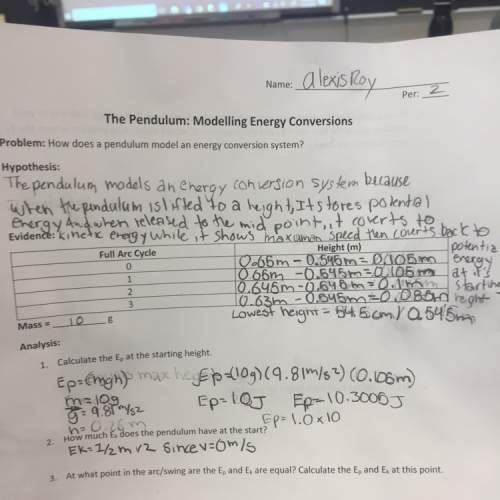
Physics, 26.06.2019 19:20 davidsouth444
You pull a solid iron ball with a density of 7.86 g/cm^3 and a radius of 1.20 cm upward through a fluid at a constant speed of 7.00 cm/s. the fluid exerts a drag force that is directly proportional to speed, and the proportionality constant is 0.950 kg/s. what is the magnitude of the force (in n) you exert on the ball? (you may ignore the buoyant force.)

Answers: 3


Another question on Physics

Physics, 21.06.2019 22:10
How would doubling the made of an object change the objects potential energy
Answers: 2


Physics, 22.06.2019 17:00
In the future, people will only enjoy one sport: electrodisc. in this sport, you gain points when you cause metallic discs hovering on a field to exchange charge. you are an electrodisc player playing the popular four disc variant. the disks have charges of qa = −8.0 µc, qb = −2.0 µc, qc = +5.0 µc, and qd = +12.0 µc. (1) you bring two disks together and then separate them. you measure the resulting charge of these two disks and find that it is +5.0 µc per disk. which two disks did you bring together? (a) a and b (b) a and c (c)a and d (d)b and c(e) b and d (f) c and d. (2) you bring three disks together and then separate them. you measure the resulting charge of these three disks and find that it is +3.0 µc per disk. which three disks did you bring together? a, b, and c (a) a, b, and d (c) a, c, and d (d) b, c, and d. (3) given the resulting charge of each disk measured in (b) is +3.0 µc, how many electrons would you need to add to a disk of this charge to electrically neutralize it? electrons
Answers: 3

Physics, 22.06.2019 19:40
12. a body is a particular amount of matter. it can be a solid, liquid or gas. it can be described as existing in a. size and shape. b. motion and force c. time and space. d. location and movement.
Answers: 2
You know the right answer?
You pull a solid iron ball with a density of 7.86 g/cm^3 and a radius of 1.20 cm upward through a fl...
Questions

Biology, 11.07.2019 02:30

Mathematics, 11.07.2019 02:30


English, 11.07.2019 02:30

Engineering, 11.07.2019 02:30


Geography, 11.07.2019 02:30

Engineering, 11.07.2019 02:30


Engineering, 11.07.2019 02:30

Physics, 11.07.2019 02:30

Engineering, 11.07.2019 02:30

Mathematics, 11.07.2019 02:30


Engineering, 11.07.2019 02:30

Biology, 11.07.2019 02:30

Engineering, 11.07.2019 02:30



Engineering, 11.07.2019 02:30




